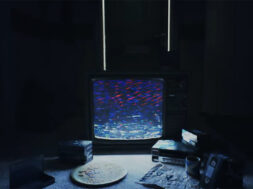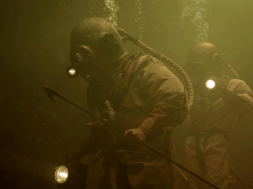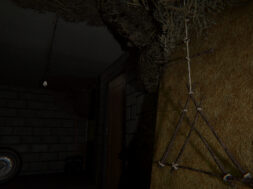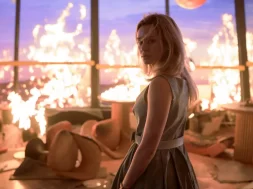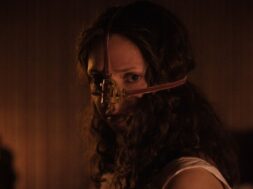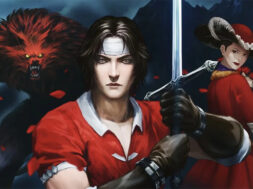5 Years Later: ‘Goosebumps’ Brought R.L. Stine’s Twisted Imagination to the Screen With Epic Execution
Reader beware…
I was out of breath, having hurried to the library as fast as I could so as to have enough time to get to class before it started. Grade school teachers were sometimes less than understanding when it came to tardiness, so I had to make it quick. The librarian spotted me and smiled. She knew why I was there; she had seen me every morning for two weeks, after all. She nodded. My heart skipped a beat. She looked down and motioned to the “Returns” bin. I walked over and reached inside.
The cover was folded over and the sickly green raised font at the top of the paperback was cracked and faded, but it was there all the same. In my hands. The first Goosebumps book I would ever read.
It was called The Ghost Next Door and, as I would come to find out, it was written by a man named R.L. Stine. Goosebumps books were all anyone talked about at lunch and recess, quickly becoming the Holy Grails of our small school library, their immense popularity making them nearly impossible to borrow out. Despite an inherent aversion to all things scary, I became caught up in the popularity of the series and, like my classmates, grew to quickly revere the author’s name as a titan of all that is spooky and strange.
Over time, I went from eager borrower to avid collector, the Goosebumps series planting the seeds in my young mind that would grow into a lush and vibrant love for the horror genre. It branched beyond the written word, bleeding into hats and t-shirts, buttons and notebooks. In time, the characters leapt off of the page and onto the screen. When the TV show premiered on Fox Kids’ in 1995 with The Haunted Mask, my friends and I had a big party— our own spooky Super Bowl of scary. We watched the show religiously after that, thinking all the while, “this is great, but imagine if they made a movie…”
The idea of a Goosebumps movie was a dream of every 90’s kid who ever picked up one of R.L. Stine’s books. The movies offered limitless possibilities for R.L. Stine’s creations and, although we didn’t realize it, it was precisely that boundless imagination that would go on to to stall the feature over the course of the next twenty years.
It was 1998 when 20th Century Fox first attempted to mount a Goosebumps feature, bringing on acclaimed director Tim Burton to direct. Despite the franchise being at the height of its popularity, neither Burton nor the studio could decide on a story, monster or scenario to adapt. Instead the project sat in limbo for years until its franchise popularity dimmed and a movie no longer seemed to be a lucrative option for Fox.
A decade later the property was acquired by Sony’s Columbia Pictures and put back into development. Screenwriters Scott Alexander and Larry Karaszewski joined the project and decided to try something different. Rather than reaching for a specific story, they decided to craft a world where the multitude of creatures that dwell in R.L. Stine’s narratives could all co-exist. Moreover, they would imbue the story with the creator himself, creating a character out of the perceived persona of the legendary author and constructing a story that was as much a tribute to the fanbase surrounding the franchise as it was an adaptation of its contents.
It was that core idea that set the stage for what would become Goosebumps (2015) several years later, the culmination of a near 20 year journey to the screen and the realization of so many twenty and thirty-somethings’ grade school dreams. The movie landed as a sleek, funny and appropriately spooky love letter to every facet of the Goosebumps legacy, spanning beyond the original 62 book run and into every corner of the sprawling franchise.
Still, as a lifelong Goosebumps fan, particularly of that initial run of books, it wasn’t just the energetic narrative, Jack Black’s brilliant characterization of R.L. Stine and Danny Elfman’s wonderfully macabre score that made me fall in love, it was the seemingly endless parade of references. Even as an astute student of the Goosebumps milieu, I could barely keep track of some of what I was seeing, desperately trying to chronicle every last monster’s face even as a sea of Stine’s villains flowed by before my eyes.
Right at the start we’re introduced to R.L. Stine’s daughter Hannah, played by Odeya Rush— a character I recognized from the first Goosebumps book I had ever picked up, The Ghost Next Door. While something of a spoiler, recognizing her true identity’s surreptitious presence in the story immediately clued me into the sort of inclusions I could come to expect in the film.
From the moment R.L. Stine’s library of frightful tomes is unleashed upon the world, his characters come at the viewer hard and fast. I giddily watched as the definitely not friendly Lawn Gnomes from Revenge of the Lawn Gnomes tied up Stine in the vein of Gulliver’s Travels and attempted to slowly pull him into the oven. And I’d be hard pressed to deny the joy I felt when the Jack Black voiced Invisible Boy from My Best Friend is Invisible revealed himself to still be a threat at the film’s conclusion.
The film is just as concerned with bringing the world of the books to life as it is exploring the consequences of such a thing. It finds disarmingly calming moments in a dilapidated amusement park evoking shades of Welcome to Horror Land only to subvert that perceived peacefulness when the titular menace from The Blob that Ate Everyone levels the old carnival ground with a tidal wave of purple goo. There are even book titles seen in Stine’s library, like Attack of the Mutant and Deep Trouble, that never manifest onscreen otherwise, but feel ever-present in the narrative through the lens of a fan by virtue of their inclusion.
For every Abominable Snowman of Pasadena Yeti crashing through the frame, there is a The Cuckoo Clock of Doom grandfather clock seen briefly in the background of R.L. Stine’s basement, offering both overt and covert Goosebumps world-building that washes over every second of its runtime. And as much enjoyment as I get watching Night of the Living Dummy’s Slappy cruise around in The Haunted Car’s haunted car, it’s when I’m squinting at the coalition of monsters descending on the gymnasium in the final act that my imagination runs wild.
There are Creeps from Calling All Creeps!, Scarecrows from The Scarecrow Walks at Midnight, the Swamp Monster from How to Kill a Monster and even bees from Why I’m Afraid of Bees. Hell, the giant praying mantis from A Shocker on Shock Street rips a kid out of a window! Every second of the finale is so chock-full of Goosebumps baddies that the mind reels while taking it all in, imagining each and every one of the terrifying possibilities all of those creatures might present. Like Cabin in the Woods (2011) before it, Goosebumps challenges the viewer to watch again and again, if only to catch a glimpse of a malicious favorite you might’ve missed in the blink of an eye the first several go-rounds.
As if several frames of Carly Beth donning The Haunted Mask as she frolics on her way toward the ferris wheel or sighting the towering Pumpkin Head monster from Attack of the Jack-O’-Lanterns wasn’t enough to sure up my affinity for the movie’s dedication to its source material, I was hit with the end credits sequence. Inextricable from the legacy and memorability of the Goosebumps book series is Tim Jacobus’ stunning artwork. I can think of no better way of concluding such a testament to the book series than by celebrating Jacobus’ contributions, which the animated credits sequence does in spades.
Danny Elfman’s score kicks in as a faux Goosebumps book featuring a screaming Jack Black as R.L. Stine above the title The Invisible Boy’s Revenge flies at the screen. From there, the viewer is taken on an animated trek through Tim Jacobus’ iconic artwork. Flying through the cover of Welcome to Dead House, the camera passes over a skeleton wearing a chef’s hat a la Say Cheese and Die! and emerges in a cemetery overseen by the spirit from Ghost Beach. It continues, traversing the covers, bringing to life Revenge of the Lawn Gnomes, A Shocker on Shock Street, The Scarecrow Walks at Midnight, The Werewolf of Fever Swamp, Attack of the Jack-O’-Lanterns, The Abominable Snowman of Pasadena and Night of the Living Dummy.
Whether it be The Werewolf of Fever Swamp tearing apart a grocery store and drooling all over his creator or the lumbering mummies from The Curse of the Mummy’s Tomb joining the fray, the Goosebumps movie delivers R.L. Stine’s twisted imagination to the screen with epic execution. And for lifelong fans of the ghoulish, the silly and the grim that the Goosebumps legacy carries with it, there’s little more gratifying than combing through the veritable smorgasbord of references that the movie has baked within its 103 minutes.
When I handed my daughter a copy of The Ghost Next Door decades after I first retrieved my own from my elementary school library “Returns” bin, I saw a twinge of uncertainty in her eye. She stared at the eerie cover and then back up at me. Still, as I read her the book over the following week, her trepidation transformed from cautious uncertainty to edge-of-her-seat excitement. The argument transitioned from whether or not to read it to whether or not I would read just one more chapter, no matter how late it was on a school night. And later, when we watched the Goosebumps movie together, she couldn’t help but tug on my shirt and whisper, “Hannah! Like from The Ghost Next Door!”
There’s a special bond created between the mind of a young reader and the books that shape their interests. Although I moved on to other stories and other obsessions, those books, the artwork and R.L. Stine never left me, always present in the back of my mind as the epitome of how uniquely terror and fun can intermingle when approached in the right way. And while it would have been interesting to see Tim Burton’s take on the material, I’m grateful that Rob Letterman’s Goosebumps shared my admiration for the series and worked hard to faithfully represent it at every turn.
The movie is bursting at the seams with Goosebumps lore, containing far more allusions than mentioned here and far more than I’ll probably ever be able to catch. Sure, I caught the Snake Lady from Give Yourself Goosebumps: Escape From the Carnival of Horrors mingling amongst her dreadful peers, but I’d be lying if the many Goosebumps Series 2000 and Give Yourself Goosebumps references didn’t go over my head until I read up on them. And yet, in my eyes, that’s all the more reason to watch the movie again and again, just as my grade school self would’ve done and, now, just as my own kids like to do.
As it turns out, some obsessions never change, they evolve, and the Goosebumps movie is a scary good example of that. And, of course, thanks to R.L. Stine, I’m always in for a scare.
